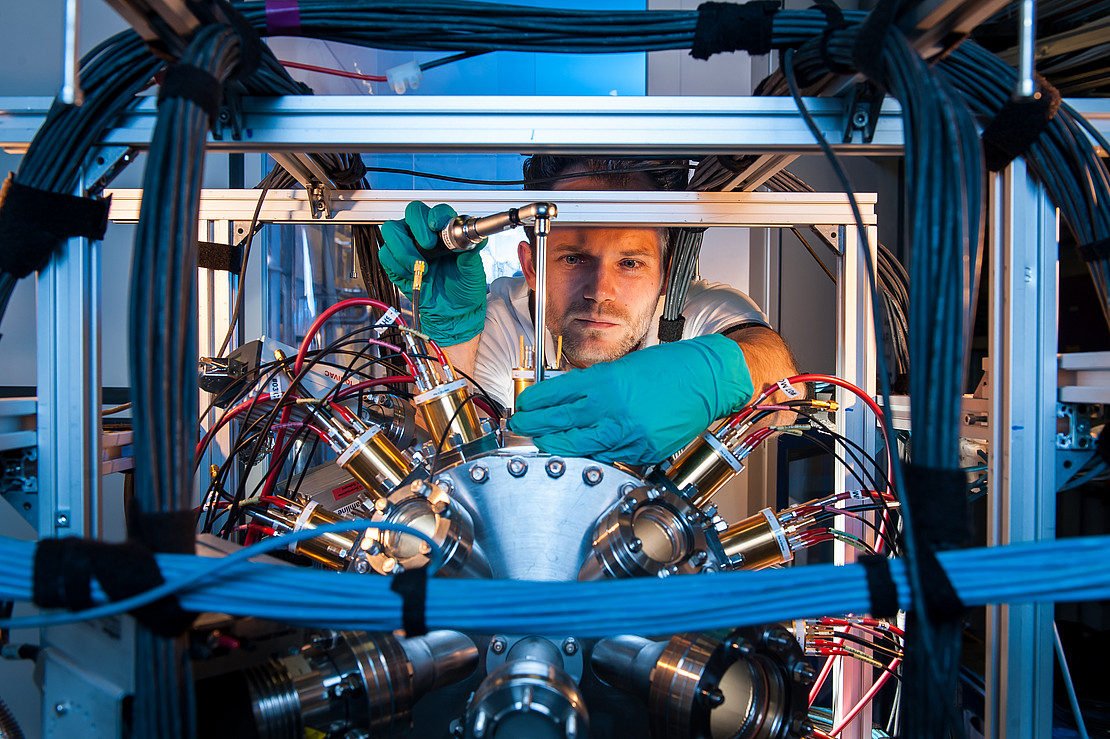This page contains automatically translated content.
New findings improve interpretation of photoionization experiments in physics
 Image: European XFEL
Image: European XFELPhotoelectron spectroscopy is one of the most important and informative methods in experimental physics. Molecules or atoms, for example in large-scale research facilities, are bombarded with intense light; as a result, they emit negatively charged electrons. Analysis of the emitted electrons allows conclusions to be drawn about the structure of the matter under investigation, for example about the original location (wave function) of the electrons or the chirality of molecules. Usually, electrons leave the atom or molecule symmetrically with respect to the direction of propagation when the light used has a relatively long wavelength; increasingly asymmetrically at short wavelengths. It is known that there are exceptions to this approximation for neutral matter, but until now it has never been confirmed for ions. Now, experiments led by a group of experimental physicists in Kassel have shown that under certain conditions, even at long wavelengths, electrons from ionic matter pick up pulses of light particles (photons) and are thus emitted asymmetrically. Spectroscopy on ions is an essential component of many nonlinear and time-resolved studies, which have been greatly extended by free-electron lasers. The new findings expand the possibilities of such experiments; more importantly, they must be taken into account in the future when evaluating the resulting data in order to correctly analyze and interpret the results.
The principle used at free-electron lasers to generate ionic matter is the multiple absorption of light particles in a very short time (less than a millionth of a millionth of a second). When multiple such photons are absorbed, multiple electrons can also be extracted in rapid succession. Thus, ionic matter is gradually created with different charge states depending on the number of photons absorbed. This so-called sequential (nonlinear) photoionization therefore enables the study of ionic matter in a revolutionary way that was first made accessible by free-electron lasers (FELs).
When the wavelength of a photon is significantly larger than the absorbing part of the matter, the resulting electron emissions can normally be described by a dipole interaction, that is, they are emitted symmetrically. However, there are several circumstances that lead to asymmetric scattering. One example is when the wavelength of the photon is relatively short, because it then emits a "bump" to the electron. "This can be thought of as a cork that only moves up and down, but not forward or backward, in long water waves on the ocean," illustrates Dr. Markus Ilchen, junior research group leader at the University of Kassel and lead author of the study. "If the waves become very small, they will also impart momentum to the cork in the forward direction."
Scientists from an international consortium led by the University of Kassel, the European XFEL and DESY (both in Hamburg) have now found a similar momentum transfer in ionic matter produced by sequential photoionization. The research group used for the first time a special operation mode of the free-electron laser FERMI in Italy to irradiate argon atoms in the gas phase with extreme intensity (petawatts per cm²) and thus to efficiently realize angle-resolved spectroscopy on singly charged argon. The wavelength of the radiation used was so long that the electrons should have scattered symmetrically. However, the clearly visible momentum transfer resulted in asymmetric emission in neutral and even stronger in ionic argon. This investigation was made possible by the targeted exploitation of a minimum in the interaction probability between the light and the atoms (a so-called Cooper minimum), which allows a kind of zoom into the momentum transfer.
The scientists expect the new findings to provide a more accurate description of photoionization at large intensities, as well as more in-depth applications in the fields of solid-state physics, astrophysics, and time-resolved studies of, for example, chiral matter. The study of chirality is the subject of a collaborative research center at the University of Kassel; here, handedness, i.e., the mirror-image structure of molecules, is investigated, e.g., by means of asymmetric photoelectron emission.
Original article: M. Ilchen, G. Hartmann, A. Knie et. al. Nature Communications Volume 9, Article number: 4659 (2018).
https://www.nature.com/articles/s41467-018-07152-7
https://doi.org/10.1038/s41467-018-07152-7
Contact:
Dr. André Knie
University of Kassel
Department of Experimental Physics IV
Tel: +49 561 804-4062
Email: knie[at]physik.uni-kassel[dot]de
Dr. Markus Ilchen
University of Kassel/European XFEL
E-mail: ilchen[at]physik[dot]uni-kassel .de
Dr. Gregor Hartmann
University of Kassel
Department of Experimental Physics IV
E-mail: gregor.hartmann[at]physik.uni-kassel[dot]de